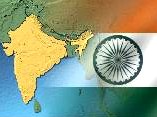


All You Need to
Know About INDIA
Government
Politics
Administrative divisions
Geography
Economy
Demographics
Culture
Last updated on
Sunday, October 29, 2006 19:28
- Mac. Dream. MX
India has a rich and unique cultural heritage, and has managed to preserve its established traditions throughout history whilst absorbing customs, traditions and ideas from both invaders and immigrants. Many cultural practices, languages, customs and monuments are examples of this co-mingling over centuries. Famous monuments, such as the Taj Mahal and other examples of Islamic-inspired architecture have been inherited from the Mughal dynasty. These are the result of a syncretic tradition that combined elements from all parts of the country.

The magnificent Brihadisvara Temple, built 1000 years ago

The Taj Mahal in Agra is India's most popular tourist destination
Indian music is represented in a wide variety of forms. The two main forms of classical music are Carnatic from South India, and Hindustani from North India, each of which has several popular sub classes. Popular forms of music also prevail, the most notable being Filmi music and Bhangra music. In addition to this are the diverse traditions of folk music from different parts of the country. Many classical dance forms exist, including the Bharatanatyam, Kathakali, Kathak, Kuchipudi, Odissi, and Manipuri. They often have a narrative form and are usually infused with devotional and spiritual elements.
The earliest literary traditions in India were mostly oral, and were later transcribed. Most of these are represented by sacred works like the Vedas and the epics of the Mahabharata and Ramayana. Sangam literature from Tamil Nadu represents some of India's oldest traditions. There have been many notable modern Indian writers, both in Indian languages and in English. Millions of ancient handwritten manuscripts have been identified and classified. India's only Nobel laureate in literature was the Bengali writer Rabindranath Tagore. India is the third largest newspaper market in Asia with an estimated circulation of at least 66 million copies daily in 2003.
The nation also produces the world's largest number of motion pictures every year. Most cinema productions are based in Mumbai, Noida, Chennai and Hyderabad. Popular cinema industries are based on regional languages such as Hindi, Punjabi, Urdu, Telugu, Tamil, Malayalam, Bengali, and Kannada languages. The growing film industry is backed by film schools.The world famous Asian Academy Of Film & Television attracts students from 65 countries across the globe.Hence making India the hub for film education.

Varanasi, the religious and cultural center of India for thousands of years is the oldest living city in the world and is considered as one of the most sacred places of pilgrimage for Hindus irrespective of denomination
Religious practices of various faiths are an integral part of everyday life in society. Religion in India is a very public affair, with many practices imbued with pomp and vitality accompanying their underlying spiritual qualities. Education is highly regarded by members of every socio-economic stratum. Traditional Indian family values are highly respected, and considered sacred, although urban families have grown to prefer a nuclear family system, owing to the socio-economic constraints imposed by the traditional joint family system.
The cuisine of India is diverse, as ingredients, spices and cooking methods vary from region to region. Rice and wheat are the staple foods in the country. The country is notable for its wide variety of vegetarian and non-vegetarian cuisine. Spicy food and sweets are popular in India. Traditional dress in India greatly varies across the regions in its colours and styles, and depend on various factors, including climate. Popular styles of dress include the traditional sari for women and the traditional dhoti for men.
India's national sport is field hockey, although cricket is now the de facto national game. In some states, particularly in the northeast, football (soccer) is the most popular sport and is widely watched. In recent times, tennis has gained popularity in India. Chess is also gaining popularity with the rise of the number of recognised grandmasters. The most commonly held view is that chess originated in India. Traditional indigenous sports include kabaddi, Kho Kho and gilli-danda, which are played in most parts of the country.
India is also known as a land of festivals. A melting pot of many religions, India has a rich diversity of festivals, many of which are celebrated irrespective of caste and creed. The most widely known and popular festivals include the Hindu festivals of Diwali and Holi The Sikh festival of Vaisakhi and the Muslim festivals of Eid ul-Fitr and Eid ul-Adha. A number of festivals are common to most parts of India; however, they may be called by different names in the various parts of the country or may be celebrated in a different fashion and style.
Terms
of Service, Privacy
Policy, Contacts and Credits
© 2006 thanneer91. All rights reserved
Page tested with Internet Explorer and Mozilla Firefox
Best viewed at a resolution of 600 X 800
Any unauthourized duplication of this site is strictly prohibited and liable
to prosecution
Timeline of Indian History ~~ Military History of India ~~ Indian Independance Movement